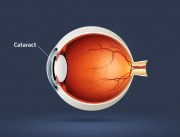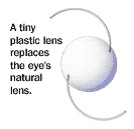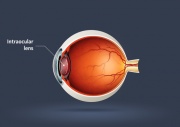Cataract Surgery: How it Works and Frequently Asked Questions
Introduction
"Current wisdom" among eyecare practitioners is that we will all get cataracts if we live long enough. In fact, cataracts begin to form even in childhood, but usually don't require any treatment or attention until much later in life. In most people, cataracts don't become an issue until their 50s or 60s or later, although it is possible to delay their development to some extent.
Technically, a cataract is defined as anything that interferes with the transparence or clarity of light passing through the crystalline lens of the eye, located behind the iris. By this definition, even a small dot is a cataract, but it is not clinically significant.
The term "clinically significant" just means that the vision we experience has begun to be effected by the cataract and we should consider cataract extraction surgery (CES) to have them removed. An eyecare practitioner will do a vision exam, look into the eye and evaluate your symptoms to help you consider your options. The doctor will recommend treatment or help determine if it is necessary to take further action now, or if it would be more appropriate to wait until symptoms become more noticeable.
Two things we should do to delay the development of later cataracts is to make sure that our children are protecting their eyes from the harmful ultraviolet (UV) rays of the sun with good-quality, wrap-around sunglasses, and that they eat a healthy diet. These two things, beginning in early childhood have been shown in various studies to delay cataract formation later in life.
A cataract is located within the eyeball; it is not a film that covers the vision. Because it is within the eye itself, new glasses or contacts won't help restore better vision, nor is it treatable with any refractive surgery such as LASIK.
There is no treatment, supplement or medication that has ever been shown to cure cataracts. The only way to improve vision once cataracts have formed is to remove the cloudy lens from the eye with cataract extraction surgery (CES). The good news is that CES has one of the highest success rates of any surgery performed today, and important improvements to CES are happening all the time. No one should be forced to tolerate decreased vision due to cataracts when it is so easily corrected.
How Does the Surgery Work?
There are two basic parts to CES; the first is to remove the cloudy lens from the eye and the second is to implant an artificial lens that will replace the focusing power of the natural lens once it is removed.
During pre-testing, the curvature of the front of the cornea and an ultrasonic measurement of the length of the eye will be obtained. A refraction, or measurement of nearsightedness, farsightedness and/or astigmatism will be done.
The surgery is performed under a powerful microscope and is almost always done with a local anesthetic. A typical, uncomplicated cataract extraction usually takes less than 15 minutes, although your visit to the surgical center will last about 90 minutes.
A tiny incision is made through the white of the eye near the clear cornea. The surgeon will cut a hole in the front wall of the lens capsule, and then use ultrasound to break the cloudy lens into small pieces. A suction device is used to remove the pieces and the surgeon will then make sure the back wall of the capsule is smooth and polished before implanting the intraocular lens (IOL), placing it right into the capsule which helps hold it in place.
The power of the IOL is calculated using the data gathered in pre-testing to reduce the patient's future need for eyeglasses, contact lenses or LASIK. A large majority of patients who have cataract surgery are much less dependent on corrective lenses than they were before having surgery.
Recently, femtosecond lasers have gained approval in the US for use in cataract surgery to create the initial incision, removing the front of the lens capsule and fragmenting the lens so it can be removed. The purpose of using a laser for these procedures is that it makes the entire surgery faster and therefore reduces the risk of complications.
No surgery result can be guaranteed, but patients with cataracts should be happy to learn that cataract removal surgery is one of the safest and most successful types of surgery being performed today. The few complications that do occur are usually resolved without any permanent effects.
After the Surgery
CES is done either in an operating room or in a freestanding surgery center.
Recovery should be short and uncomplicated for most patients in good health and without any other major eye problems. Patients scheduled for CES need to make arrangements for someone to drive them home after the procedure; you will be given a pair of sunglasses (if you don't already have them) to protect the eye from bright light and glare.
If you are sleepy when you get home, you can relax in bed for a few hours. Follow your surgeon's advice about using the eye shield to protect your eye during sleep; while most people won't need the shield during the day after the first few hours, your surgeon may want you to wear it during the night for about a week.
Your surgeon will prescribe medicated eye drops to use in the eye several times a day for a few weeks, to reduce the chance of infection and the effects of inflammation. Follow all the surgeon's recommendations exactly; if you don't understand something, ask questions to clarify the issues involved.
As might be expected, most people experience some redness and blurry vision during the first few days after cataract removal.
Some patients might have scratchiness or dryness sensations, but these should go away as your eye heals, unless you had problems with dry eyes before your surgery.
Statistically, about 95% of eyes that had no prior problems or eye diseases achieve 20/40 visual acuity or better, even without glasses. (This is good enough for people to drive without glasses in most states and provinces.) In all eyes, even those with pre-existing conditions other than cataracts, 90% have a good outcome. Fewer than 2% of all eyes had sight-threatening complications from their cataract extraction surgery.
There may be short period of adaptation to the implanted IOL which might include "waviness" or other distortions of vision. These are usually gone after about an hour.
Usually your eye will be examined briefly before you leave the surgery center, just to make sure there are no complications. In addition, you will be scheduled for a one-day post-op checkup with either your own eyecare practitioner or the surgeon who performed your surgery, just to make sure there are no complications. The total recovery period in most cases is about a month in total.
Try to avoid strenuous activity for a few weeks, but there is no need to limit the use of your vision, which is usually much better after CES. You can read, do work on a computer, watch TV, or enjoy any other visual activity.
After-Cataract
Probably the most common adverse event after CES is called an "after cataract". Some patients experience a clouding of the back surface of the lens capsule within the eye, usually within a few weeks. A simple office procedure using a laser will be used to cut a hole in the capsule so vision improves once again. No one really knows why some people develop this and others don't, but it is simple to fix, painless and needs no anesthetic at all. Once this is done, it can't come back again.
Frequently Asked Questions
The following are common questions asked by people who have been diagnosed with cataracts and who have been advised to have CES.
What are the Benefits of Cataract Extraction Surgery?
Patients with significant cataracts often experience reduced vision, which can result in frustration or decreased self-confidence in social situations because of the inability to recognize people. In addition, they might have feelings of insecurity or fear a loss of independence.
The benefits of CES are those that would be expected from improved vision, such as reading or watching TV, passing a driver's license exam and driving at night, engaging in hobbies and seeing the faces of loved ones.
Something most people don't think about but which is important to an eyecare practitioner is that significant cataracts interfere with his or her ability to see the back of the eye during a vision examination. If the patient cannot see through a cataract, neither can the doctor; it might be difficult or impossible to detect problems that might be happening in the back of the eye such as diabetic retinopathy or the effects of glaucoma.
How do I know if CES can help me?
If your eyes are healthy other than having cataracts, removing the cloudy lens will be likely to restore good vision. If there are other problems within the eye, CES will probably not help you to see better, but will usually restore vision to pre-cataract levels.
The examination and testing done before CES will give the eyecare practitioner and the surgeon a good indication of what vision will be like after the procedure.
When Should CES be done?
When your decreased vision is interfering with your daily life, you and your eyecare practitioner should consider CES. If poor eyesight due to cataracts is frustrating and you can't see to perform everyday tasks, most eyecare practitioners will recommend their removal.
In the past, cataract patients were required to wait until their vision was so impaired they would have been considered to be legally blind. Then, CES was done only as a last resort because the outcome of the surgery was terrible, but now, surgeons prefer to do CES much earlier in the process because the surgery itself is easier to do and success rates are much higher.
Why do I need an artificial lens implanted?
The implanted Intraocular Lens (IOL) replaces the focusing power that the cloudy lens had, so you can see more clearly after the surgery. Without it, you would probably need very strong eyeglass or contact lenses to see anything.
Before IOLs were available, patients who had CES were extremely dependent on their glasses or contact lenses; an IOL implanted in the eye is one of the reasons why this surgery is done earlier and the outcomes are so much better.
The IOL is made from very high-quality surgical plastic and it does not cause any reaction by your immune system.
Can I have CES if I have diabetes or glaucoma?
Yes, if the diabetes is adequately controlled it should not pose a problem; glaucoma does not usually do so either. In fact, some surgeons performing CES might also do a trabeculotomy to help control the glaucoma at the same time as CES.
Ask your eyecare practitioner and/or the surgeon about any medications you take or supplements you use and tell your surgeon about any chronic illnesses or eye disease you have.
Are cataracts removed using a laser?
No, although a high-precision ultrasonic probe is often confused with a laser.
Recently, some surgeons have begun using an ultra-high-speed instrument called a femtosecond laser. This laser is helpful in making the initial incision, cutting the hole in the front wall of the capsule, and in breaking up the cloudy lens so it can be removed more quickly and easily. Using the laser speeds up the surgery overall, which some surgeons prefer to do because they feel it may decrease the incidence of complications or adverse events.
The femtosecond laser does not do the actual surgery, but is becoming a tool (like a scalpel) to make CES faster and even more safe.
Can I get both cataracts removed on the same day?
Most surgeons prefer to do CES procedures at least a week apart, although this routine may be changing, particularly if the patient has issues with transportation to the surgery center.
If transportation to the surgery center may be difficult to arrange, ask your eyecare practitioner and/or your cataract removal surgeon about their preferences about this.
How safe is CES?
CES is one of the safest surgeries being done today; a highly experienced cataract surgeon can successfully improve vision in about 99% of all patients.
No surgery can have a guaranteed result, but with a gifted and experienced surgeon performing the procedure, even those complications that can occur are almost always treated and resolve without any permanent effects on vision.
Patients should remember, however, that his is a surgical procedure and as such, there is always a slight chance that a complication could result in loss of vision in the effected eye.
Can I get AIDS or HIV from cataract extraction?
No. No body fluids are exchanged during the procedure so AIDS is not considered a risk.
What if I decide not to have CES?
That is always your choice to make. Over several years, patients may not be aware of the gradual loss of vision is happening due to cataracts. Because the loss is so gradual, people sometimes manage to adapt to decreased vision and don't realize how compromised their vision actually is, or the difference CES would probably make to their daily living.
If for some reason you choose not to have CES, this list of possible ways you can adapt to poor vision might be helpful, if for no other reason than to point out the things you may be missing:
- Limit nighttime activities
- Use brighter light bulbs
- Use night lights
- Only drive during daylight hours, and if you are legally allowed to do so
- Use stronger eyeglasses, although there will be a point where no eyeglass lens prescriptions may actually help you to see better
- Use large print books and magazines; reading a newspaper may not be possible at all
- Stay within familiar surroundings
- Outdoors, use sunglasses to reduce glare
- Get help organizing and taking any medications so you will avoid mistakes
- Get a telephone with oversized buttons
- Use handrails or a cane to prevent a fall
- Use the "zoom" key on your computer to make the monitor more readable and increase the size of the font you use for email
- Resign yourself to not being able to see the faces of loved ones
On the other hand, if you decide to get CES, prepare yourself for these results:
- Go out to the theatre or a movie without worrying about getting home in the dark
- Use regular light bulbs
- Use nightlights anyway, they make it easier to see your way to the bathroom anyway or the refrigerator
- Pass your driving tests without worrying about your vision
- Enjoy an eyeglass prescription that is actually less strong than you had before
- Read and enjoy anything you like, from books, magazines, newspapers, your mail and cookbooks
- Go anywhere you want to go, whenever you want
- Use sunglasses anyway, they are stylish and make it easier to see in bright sunlight
- Take your medications as directed and be careful not to get them mixed up
- Use a regular phone or even a small cell phone
- Use handrails on stairs in any case, and if you have poor balance a can might help
- Use a computer to send and receive email and surf the web easily
- Enjoy the looks on the faces of your family and friends
Where can I go to get CES?
Your eyecare practitioner can make a recommendation for you to get to a really good surgeon.
Summary
If you think you might be developing cataracts, the easiest thing to do is to schedule a vision with your eyecare practitioner to be sure, and schedule your procedure when it becomes necessary. Chances are, you don't realize what you are missing.








